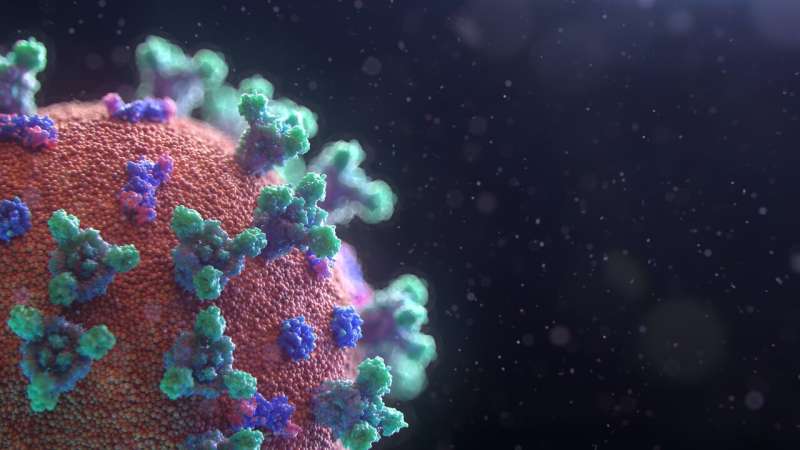Credit: Unsplash/CC0 Public Domain
Some California hospitals are close to reaching their breaking point, prompting Gov. Gavin Newsom to bring in hundreds of hospital staff from outside the state and to prepare to re-start emergency hospitals that were created but barely used when the coronavirus surged last spring.
California officials paint a dire picture of overwhelmed hospitals and exhausted health workers as the state records an average of 22,000 new cases a day. After nine months of the pandemic, they recognize about 12% of people who test positive will end up going to the hospital two to three weeks later. At the current rate, that means 2,640 hospitalizations from each day's new case total.
"We know that we can expect in the upcoming weeks alarming increases in hospitalizations and deaths," said Barbara Ferrer, health director for Los Angeles County, the state's largest with 10 million residents.
For some, "the respiratory infection becomes unbearable—they have difficulty breathing and it's very frightening," said California Hospital Association president and CEO Carmela Coyle. What starts with a spike in emergency room visits can cascade into jammed hospital beds and ultimately intensive care units.
California's hospitalizations already are at record levels, and the state has seen a roughly 70% increase in ICU admissions in just two weeks, leaving just 1,700 of the state's 7,800 ICU beds available.
"That fragile but important system may be overwhelmed," Dr. Mark Ghaly, the state's top public health officer, said Tuesday.
Hospitals in Fresno, Madera, and Kings counties in the San Joaquin Valley region of the state already have run out of official ICU space, state public health officials reported.
Instead of going into the ICU, which has special staff and equipment for the most seriously ill, patients may be sent to other beds in the emergency department or an alternate care site at the Porterville Developmental Center that can hold 123 people, Fresno County Emergency Medical Services Director Daniel Lynch told the Los Angeles Times.
Several hospitals in Los Angeles County and others in San Diego and Imperial counties are among those close to running out of ICU beds.
In response, California has requested nearly 600 health care workers to help in ICUs through a contracting agency and the federal government. It's starting a two-day program to train registered nurses to care for ICU patients and setting up links for doctors to consult remotely on ICU patients. Some hospitals are postponing elective surgeries to free up staff and beds.
Gov. Gavin Newsom recently imposed an overnight curfew, a ban on nonessential travel, and issued stay-home orders in regions where open ICU beds have dipped below 15%.
Similar concerns about patient overload and staffing shortages faded during the initial months of the pandemic, leaving most of the state's auxiliary surge hospitals barely used. But now capacity is dwindling even before the impact of infections spread by those who ignored entreaties to stay home for Thanksgiving.
"It's not just the hospital cases that we're seeing today, it's the number of positive cases that we know will go on to get hospitalized throughout the month of December," Fresno County interim health officer Dr. Rais Vohra said Tuesday.
Health officials point to a spike in health care workers themselves becoming infected and a dearth of traveling nurses who are busy in other states dealing with their own unprecedented spikes.
When specially trained critical care nurses become overwhelmed, hospitals will likely first draft post-surgery nurses to fill the void. And if they too are swamped, hospitals will shift to a team approach, where a critical care nurse oversees others with less training who can still perform many duties.
That would require waiving strict nurse-to-patient ratios that are uniquely written into law in California, something the California Nurses Association argues would inevitably endanger patients' care.
Riverside University Health System Medical Center, for instance, has opened an ICU in a former storage room, chief executive Jennifer Cruikshank told Riverside County supervisors on Tuesday. An ICU nurse who typically cares for two patients is now taking care of three, she said, and doctors and housekeepers are taking extra shifts.
In another attempt to help, the state is activating the first two of 11 alternative care sites that have a total capacity of 1,862 beds.
A site in hard-hit Imperial County, on the border with Mexico, already has 19 of its 25 available beds in use, though it can expand to handle 115 patients.
The second site is at the former home of the Sacramento Kings professional basketball team. The goal is to have the first 20 beds ready by Wednesday in a practice gymnasium, then prepare another 224 beds in the main arena—some in luxury suites where well-heeled fans once watched games.
It's still unclear what patients will be placed there, Office of Emergency Services spokesman Brian Ferguson said.
It will be staffed this time with California Medical Assistance Teams, which usually respond to disasters like wildfires, and members of Newsom's California Health Corps—paid volunteers who are often recently retired medical professionals. The state also is seeking workers from contract medical providers and the federal government.
Fresno County, with a population of about 1 million, has been pleading for state help to staff three area hospitals for several weeks, but was sent just one or two workers for each amid the nationwide shortage, Lynch said.
"We're fulfilling what we can, but it is getting harder," Ghaly said.
© 2020 The Associated Press. All rights reserved. This material may not be published, broadcast, rewritten or redistributed without permission.
























